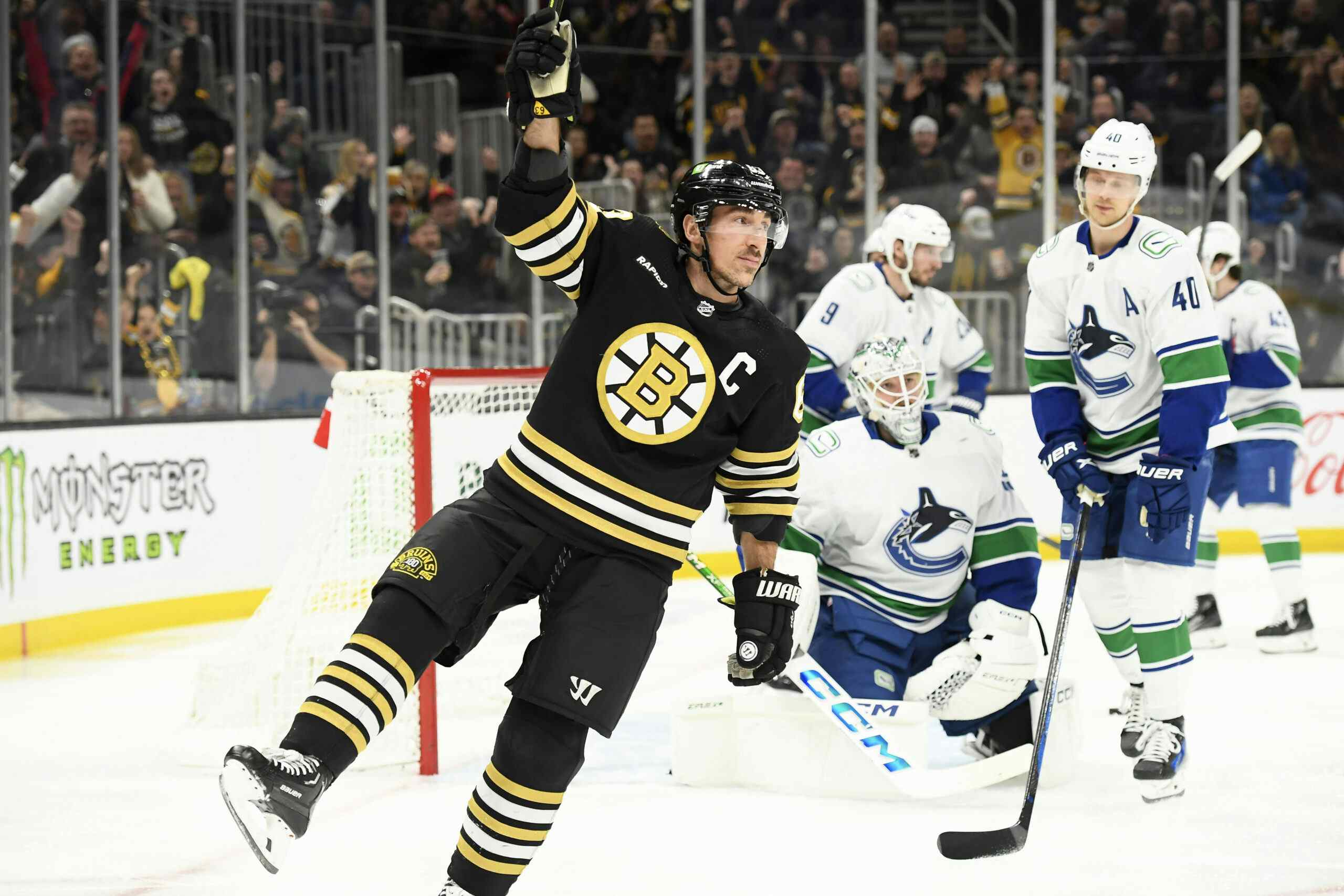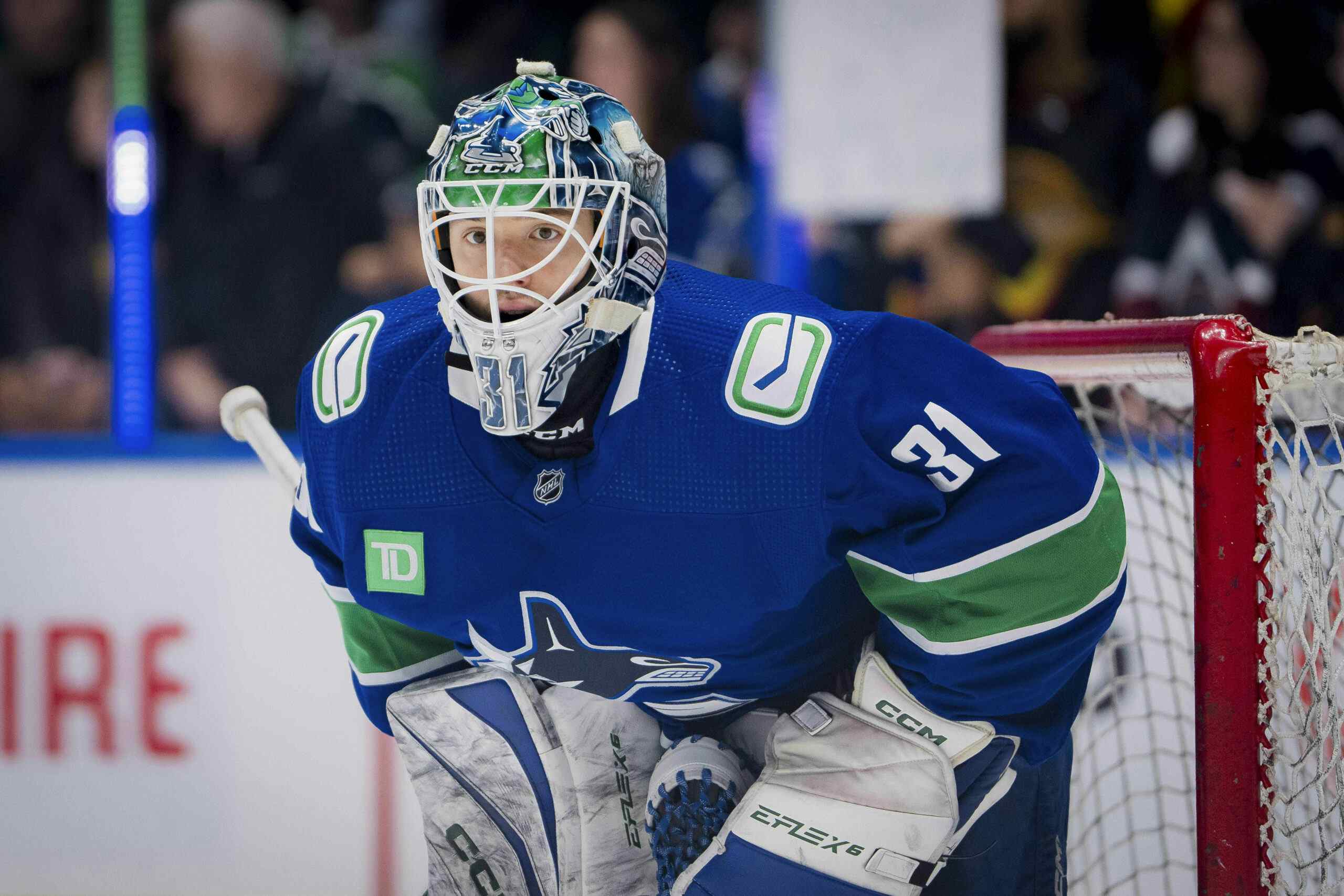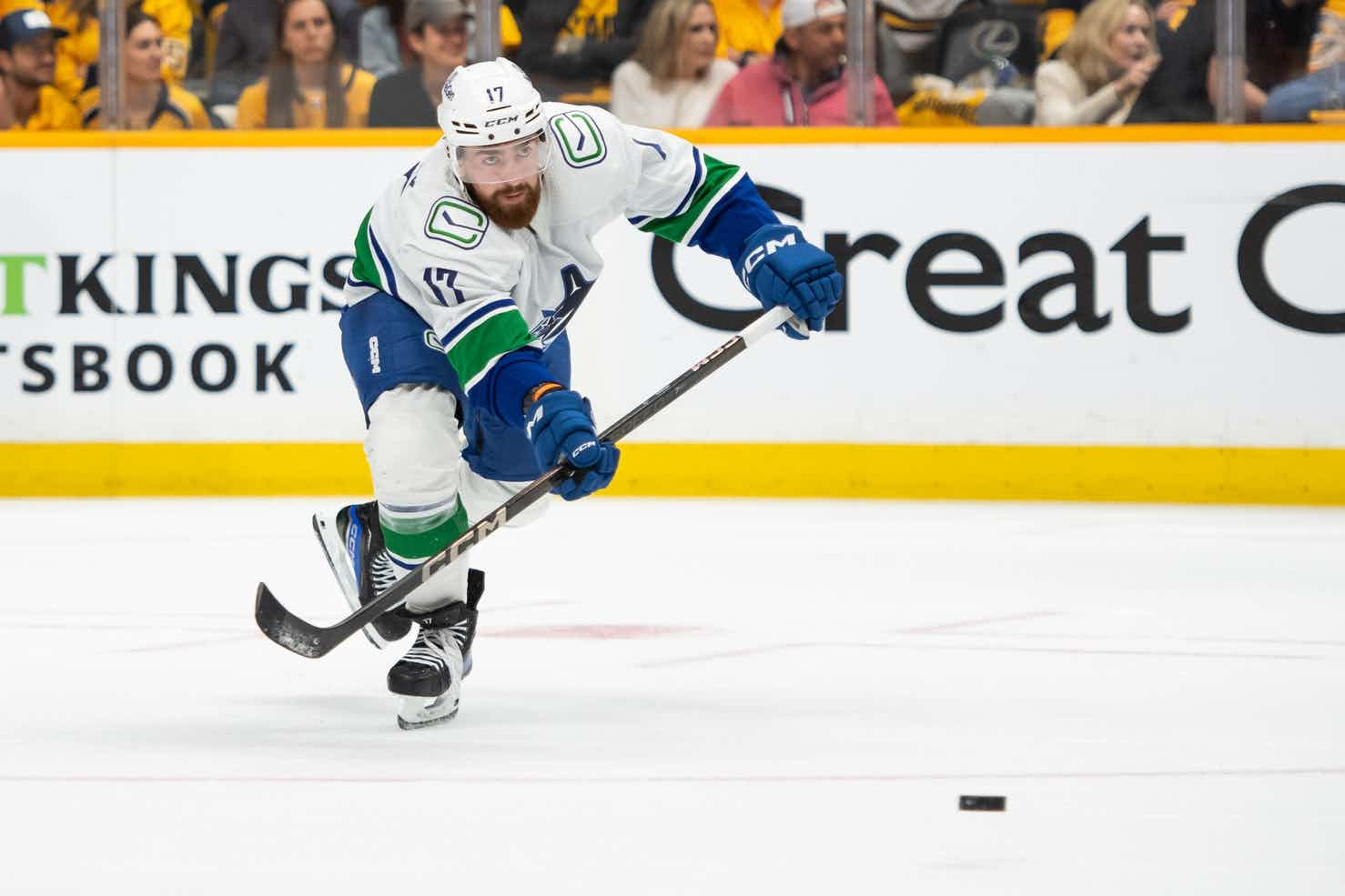Chris Higgins and the Value of the Role Player
By Jeff Angus
11 years ago
Canucks fans didn`t have much in the way of expectations for Chris Higgins after the club acquired him and Maxim Lapierre at the 2011 trade deadline.
Those two moves were largely overlooked at the time and Higgins and Lapierre were described as "depth players" and "insurance." But Higgins and Lapierre were integral parts of Vancouver`s Stanley Cup run and almost two years later, they are both playing consistent minutes for Vancouver. Higgins, in particular, has found a home with the Canucks as its Mr. Everything (a title he shares with Jannik Hansen). He can play on the power play and on the penalty kill. He is a great skater, he hits, and he is one of the best Canucks at winning one-on-one puck battles along the boards.
Let`s take a bit of a look back at Higgins and his journey over the past few years.
Early Success in Montreal
Higgins spent two years in the AHL with Hamilton before cracking the Montreal roster, and his impact with the Habs was immediate. He scored 23 goals as a 22-year-old in 2005-06, he followed that up with 22 goals in 2006-07 and 27 goals in 2007-08, respectively. His speed, tenacity, and penchant for scoring timely goals made him an early fan favourite in Montreal, and he spent a lot of time on a line with Saku Koivu.
Things started to turn sour for Higgins in Montreal during the 2008-09 season. Off-ice rumors of partying and having a negative influence on a young Carey Price combined with a groin issue that limited his on-ice effectiveness (he scored only 12 goals in 57 games). This correlation of factors led Higgins to the chopping block in Montreal. He was eventually sent to New York (along with Ryan McDonagh) in exchange for Scott Gomez (sorry for the reminder, Habs fans).
The Journeyman
Higgins’ homecoming in New York didn`t last long. He played only 55 games with the Rangers before getting shipped to Calgary at the trade deadline. In 12 games with the Flames, Higgins recorded only three points. As a free agent that summer, he didn`t have a ton of teams interested in him, and he eventually agreed to a one-year contract with the Florida Panthers, eager to get his career back on track (Higgins was only two years removed from scoring 27 goals, mind you).
He played well with the Panthers in a depth scoring role, and the Canucks had their eyes on him as a potential deadline day acquisition (the Canucks management have had their eyes on a lot of Florida players in recent years…). The club pulled the trigger, shipping Evan Oberg and a draft pick to Florida in exchange for Higgins.
His numbers with the Canucks to finish the 2010-11 season weren’t really noteworthy – two goals and five points in 14 regular season games, and four goals and eight points in 25 postseason games (along with only two PIM… pretty impressive from a player who is so involved in the physical side of things).
New teammate Alex Burrows was quick to notice the value of Higgins (and Lapierre) to Vancouver’s roster:
“Oh they’ve been huge,” the Canucks’ Alexandre Burrows said, referring to Higgins and Lapierre. “Obviously, when they first came in at the trade deadline, we didn’t really know if they were going to fit into the lineup. But they came in and really jelled with the group. They’re really thriving in their new roles.”
Finding a Home in Vancouver
It was obvious from the outset that Higgins was comfortable in Vancouver. The Canucks weren`t expecting him to score 20-25 goals, and they didn`t really need him to, either. Instead, they asked him to work his butt off, create chances for his linemates, and play responsible hockey in all three zones. He got back on track with one of his finest seasons as a pro in 2011-12, scoring 18 goals and finishing with 43 points, despite missing 11 games with a nasty staph infection.
For the most part, great professional sports teams have clearly defined roles for all of their players. And not-so-great professional sports teams don’t put their players in the best positions to succeed. Higgins isn’t a sniper. He probably won’t score 25+ goals again in the NHL. But look at the Los Angeles Kings. After acquiring Jeff Carter in 2012, all of their offensive lines fell into place. The grinders like Jarret Stoll, Dwight King, and Jordan Nolan worried about getting pucks in deep, being strong along the boards, and making safe, high-percentage plays. They generated offensive production by doing what they were told to do. The same applies to the Canucks and their 2011 playoff run.
Higgins, Raffi Torres, Lapierre, and Hansen were demons on the forecheck. Nashville and San Jose in particular couldn’t handle Vancouver’s ability to get in behind the defense. Players also have a higher sense of self worth when they are graded relative to expectations. Higgins has had many great games as a Canuck without coming anywhere near the score sheet.
An example of a great play that doesn’t get the same recognition as a goal or assist:
Even when Higgins was scoring 20+ goals with Montreal, his best attributes were his skating, tenacity, and his two-way play. The goals came naturally because of how hard he played. I think he got away from that a bit when he bounced around the league, as teams were maybe placing unrealistic expectations on him as a goal scorer. But put players in the right position to succeed – Alain Vigneault and his staff do a great job of this – and it’s a whole new ballgame.
To highlight Higgins’ versatility, I pulled up his linemates from the past few seasons from DobberHockey’s Frozen Pool Line Combinations. While he’s been Ryan Kesler’s most frequent line-mate for most of the past three seasons, he really hasn’t had a set line in his time with Vancouver:
The 2010-11 regular season (14 games):
Frequency | Strength | Line Combination |
43.17% | EV | 20 HIGGINS,CHRISTOPHER – 17 KESLER,RYAN – 21 RAYMOND,MASON |
11.12% | EV | 20 HIGGINS,CHRISTOPHER – 17 KESLER,RYAN – 26 SAMUELSSON,MIKAEL |
6.59% | EV | 36 HANSEN,JANNIK – 20 HIGGINS,CHRISTOPHER – 40 LAPIERRE,MAXIM |
The 2010-11 postseason (25 games):
Frequency | Strength | Line Combination |
26.98% | EV | 20 HIGGINS,CHRISTOPHER – 17 KESLER,RYAN – 21 RAYMOND,MASON |
18.72% | EV | 20 HIGGINS,CHRISTOPHER – 17 KESLER,RYAN – 26 SAMUELSSON,MIKAEL |
12.33% | EV | 20 HIGGINS,CHRISTOPHER – 40 LAPIERRE,MAXIM – 10 TAMBELLINI,JEFF |
11.01% | EV | 20 HIGGINS,CHRISTOPHER – 17 KESLER,RYAN – 10 TAMBELLINI,JEFF |
The 2011-12 season (71 games):
Frequency | Strength | Line Combination |
20.89% | EV | 7 BOOTH,DAVID – 20 HIGGINS,CHRISTOPHER – 17 KESLER,RYAN |
11.52% | EV | 36 HANSEN,JANNIK – 20 HIGGINS,CHRISTOPHER – 26 PAHLSSON,SAMUEL |
7.8% | EV | 36 HANSEN,JANNIK – 20 HIGGINS,CHRISTOPHER – 17 KESLER,RYAN |
7.23% | EV | 20 HIGGINS,CHRISTOPHER – 17 KESLER,RYAN – 21 RAYMOND,MASON |
5.45% | EV | 14 BURROWS,ALEXANDRE – 20 HIGGINS,CHRISTOPHER – 17 KESLER,RYAN |
The American Express trio was the most common combination for Higgins last season. It will be interesting to see if Vigneault puts them together this year if and when Kesler/Booth return. There are a lot of options, especially with Jordan Schroeder’s tremendous play.
And his point production from 2011-12:
Str | On Ice Line Combination | Points | %Total Points |
EV | BOOTH,DAVID – HIGGINS,CHRISTOPHER – KESLER,RYAN | 9 | 21.43% |
PP | BOOTH,DAVID – HIGGINS,CHRISTOPHER – HODGSON,CODY | 5 | 11.9% |
EV | HANSEN,JANNIK – HIGGINS,CHRISTOPHER – PAHLSSON,SAMUEL | 4 | 9.52% |
EV | BURROWS,ALEXANDRE – HIGGINS,CHRISTOPHER – KESLER,RYAN | 3 | 7.14% |
EV | HIGGINS,CHRISTOPHER – KESLER,RYAN – RAYMOND,MASON | 3 | 7.14% |
Considering his lack of PP time (the second unit in Vancouver gets the scraps left over from the top unit), Higgins was a solid player to have on the man advantage. He isn’t going to run a power play from the half wall, but he makes smart passes and knows his role – to get to the net and disrupt the goaltender.
The 2013 season (12 games to date):
Frequency | Strength | Line Combination |
34.05% | EV | 14 BURROWS,ALEXANDRE – 36 HANSEN,JANNIK – 20 HIGGINS,CHRISTOPHER |
17.76% | EV | 20 HIGGINS,CHRISTOPHER – 9 KASSIAN,ZACK – 40 LAPIERRE,MAXIM |
15.62% | EV | 36 HANSEN,JANNIK – 20 HIGGINS,CHRISTOPHER – 40 LAPIERRE,MAXIM |
It would be great to see Higgins come back to the Canucks after this season (he’s an unrestricted free-agent following this campaign). I’d wager the team would be open in giving him a two or three year deal in the $2 to $2.5 million range (he currently makes $1.8 million per season). If he moves on, his time in Vancouver shouldn’t be overlooked. He’s been one of the best role player the Canucks have had in recent memory, and his ability to play a variety of roles has been a huge bonus to Vigneault because of how he likes to deploy his forwards.
Higgins’ versatility and consistent work ethic have allowed him to flourish again as an NHL player in Vancouver. He turns 30 this summer and is set to become an unrestricted free agent once again. If he wants to maximize the money he receives on his next contract, it probably won`t come with the Canucks. However, I’d imagine the team would love to bring him back on a reasonable two or three year deal.
Higgins’ high school hockey coach, John Gardner, on his success in Vancouver:
“The NHL’s funny. If you get with the right people, you can be successful.”
Previous Posts from Jeff:
Recent articles from Jeff Angus





